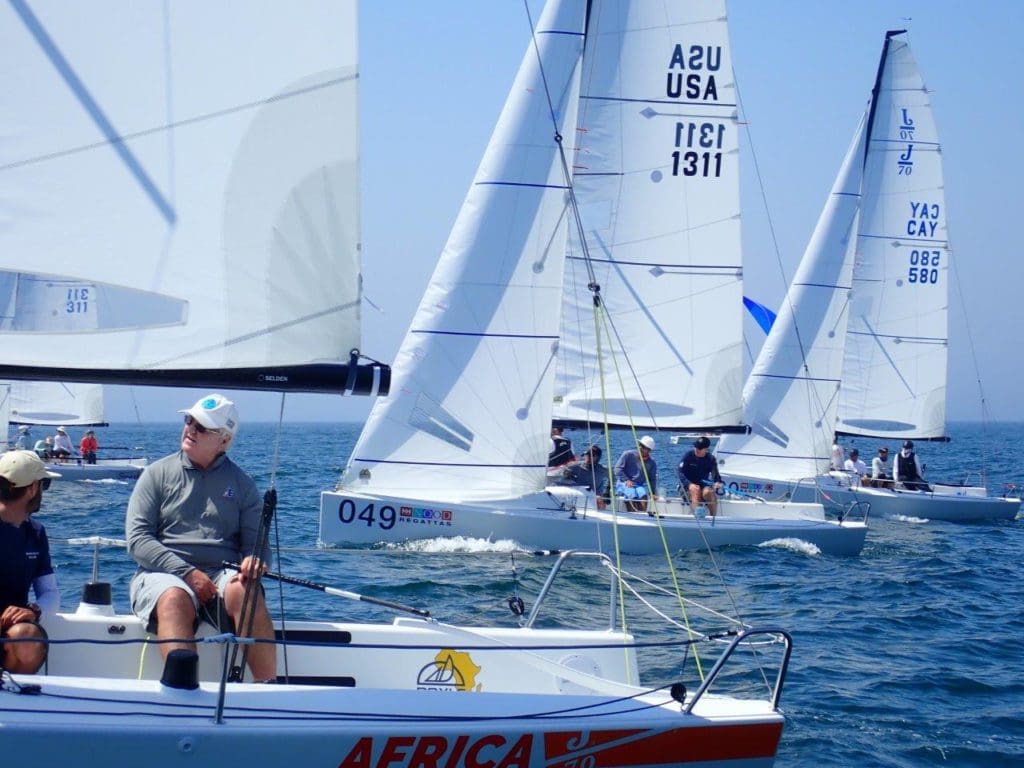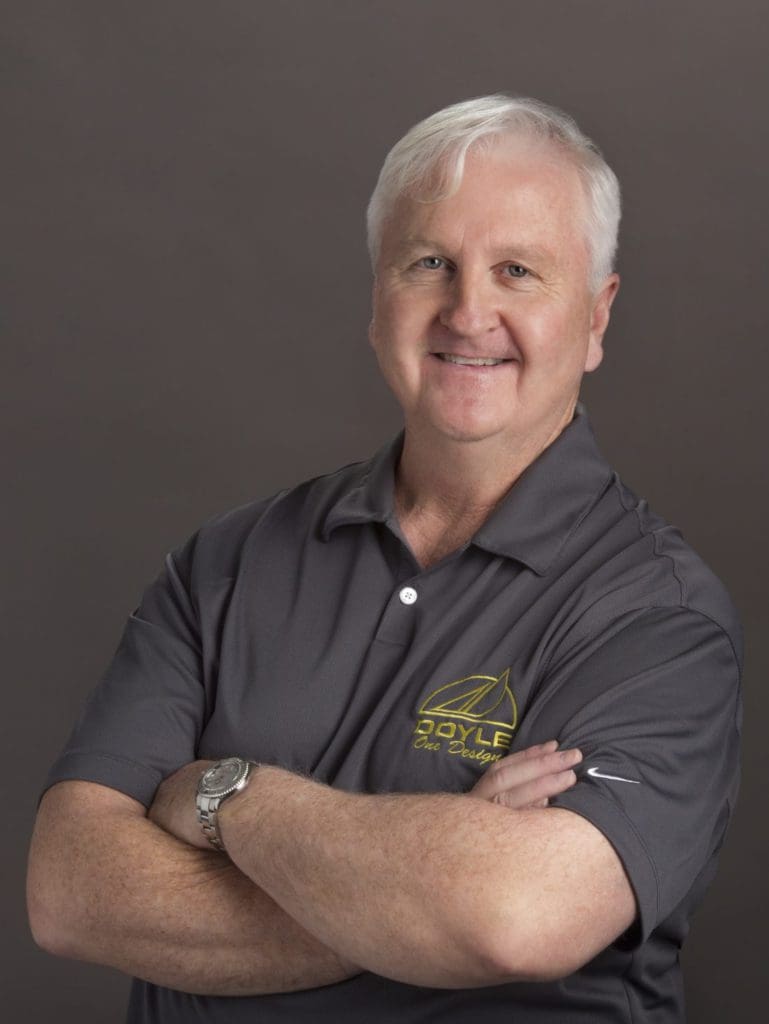Written by Jud Smith for Sailing World
The J/70 is a bit narrower than some of the other racing boats out there, so it’s a little tricky upwind because it’s more tender—it goes from being a boat that’s pretty underpowered in light air to a boat that needs to start depowering once the wind gets around 8 to 10 knots. It’s got a big jib, but the main is relatively small. The main has a nice roach profile, but it’s still not a big main by any means. In fact, there’s only around 3 feet of mast above the headstay, which is not a lot.
As a result, it’s a struggle for power in light air, constantly working hard to power up—you start by making the main full and loosen the rig tension, so you can sag the headstay to power up the jib. By 8 to 10 knots of wind, you’re already starting to depower. At 17 knots, you’ve already hit the rig’s max depowered setting. So the boat quickly goes from one extreme to another. As a result, everyone’s building versatile sails—relatively flat jibs and relatively average depth mains so that both sails can be flattened in a breeze and yet be powered up in light air. That requires a correctly set-up rig. Get it wrong, and you’ll struggle. In a way, it’s like a lot of other boats with single swept-back spreaders and a backstay.

Whether I’m coaching J/70 teams, watching J/70s race, or setting up my own boat, the first thing I always look at is the amount of mast pre-bend. That’s because, if you get the pre-bend wrong, the rig will be wrong—in every condition—which affects mainsail shape and headstay tension. The nice thing about the J/70 is that rig tension gives you a lot of control over headstay sag. That makes the J/70 work kind of like the J/24, but even more so.
When I’m coaching a J/70, one of the things I key off is the tension on the leeward shrouds. In breeze, as you’re pulling on the backstay, you’re bending the mast, which slackens the leeward upper and, if anything, tensions the leeward lower. That’s because there is a fulcrum action around the intersection of the headstay and the mast. The load on the headsail is the force sagging the forestay as the wind speed builds, while the combination of shroud, backstay and mainsheet tension are helping to support the headstay from sagging too much. The spreaders and combination of upper and lower shroud tension work together to keep the mast from overbending while tensioning the backstay to maintaining the correct amount mainsail depth and headstay sag for each windspeed.
I’m very careful about making sure that the pre-bend stays relatively consistent through the whole range of rig tension. Here’s the problem. Let’s say you’re sailing with too much pre-bend. All it takes is a centimeter or two of too much pre-bend. Then, even in 5 knots of wind, the main will be too flat. Instead of the camber at the middle stripe being 13 percent, it’s now only 12 percent or less. It takes shape and power out of the whole mainsail. The middle stripe is no longer setting up correctly for the windspeed, and that in turn affects depth at the upper and lower stripes as well. Basically, the whole sectional depth of the sail gets out of whack. So, too much pre-bend, at any rig setting, and you won’t have enough power in light air; the sail will just be too flat and wash out as you add backstay and headstay may still be too saggy. Remember, at 8 knots you’re pretty much at max power. After that you’re depowering. With too much pre-bend, you’re depowering the main too much from the start, no matter what the wind velocity and the headstay is still sagging too much. The mainsail in this scenario get washed out quickly and breaks up and the boat is overpowered because of too much headstay sag making the headsail too full.
At the other extreme, let’s say you don’t have enough pre-bend, which is rare, but let’s consider it, just to help understand more about how pre-bend works. Too little pre-bend means the uppers are too loose and the lowers are too tight (mast too straight ). Now, the main will be too deep. In light air, you won’t be able to get the leech to open—it will be shut down. The middle stripe would then set up too deep at over 15-percent cord dept, and the leech can get shut down and stall. That’s not that bad for max power in 7 to 8 knots of wind, but at 10 to 11 knots, it’s too much power. In less than 7 knots, the main gets too deep and shut down. With too little pre-bend you can’t flatten the main enough. You can’t go up even turns on the uppers and lowers because the middle of the main is too full relative to the top. The boat will always be overpowered. You end up using too much backstay and the bottom two-thirds of the main will be too deep, the backstay just flattening the top stripe and the headstay too bound up—everything’s out of proportion.
My rule is that with only shroud tension, and no backstay, I don’t want the mast to have more than 4 centimeters of pre-bend at the dock. To measure pre-bend, bring the main halyard down from the top and hold it against the track at the gooseneck. Measure the distance between the halyard and the mast at the spreaders. To make it easier, you can hoist up a little pre-bend gauge up the track with the spinnaker halyard.

Let’s say you’ve set up the mast with a Loos PT-2 gauge reading of 17 to 20 on the uppers. With that, the pre-bend might be 2 inches. Now tighten the lowers a few turns, and the pre-bend will drop to 3 to 4 centimeters—about an inch and a quarter to inch and a half. That’s what I’m always looking for. That seems to be a fast setup.
Keep in mind that the amount of spreader sweep affects how much you have to tension your shrouds to get the right amount of pre-bend, so it’s important you know that dimension. Theoretically, the sweep is identical on all boats, but the class has a kind of unpublished spreader sweep tolerance, which everyone knows. It’s around 14.25 inches to 15.25 inches. If there’s too much sweep, you have to ease your uppers a bit to compensate for that. If your spreaders are near the low end, that’s good because it means you can use more upper shroud tension at your base setting. My old boat started out with one sweep and increased slightly over time just through wear and tear. I don’t know if the holes elongated or everything just settled in. But it meant that we had to be careful how we set up our base setting. If I get on a boat and I notice there’s a problem, it’s generally because they have the tension ratio of uppers to lowers wrong. The more you tension the uppers, the more the mast bends. Tension the lowers more and the mast straightens out. Every turn you take on the lowers makes a dramatic change in pre-bend. It almost comes down to half turns, with the uppers usually going through twice the range as the lowers. Because the lowers have such an impact on pre-bend, I always set up the lowers in the 8 to 10 range on the Loos gauge and then adjust the uppers. That’s the base setting. The reason I don’t set up the rig with a lighter base setting is that you can’t get a good reading on the tension gauge on the lowers. Anything below 5 on a tension gauge is a non-reading. So you need something between 7 and 10 to get a good reading, which is why we use that as the base setting.
My base setting is for 10 to 11 knots. If I have a mast that’s bending too much, I’ll ease the uppers a turn or two to get rid of the excessive pre-bend, and if I don’t have enough pre-bend, I’ll keep tensioning the uppers until we have the right amount. It’s usually in the 17 to 20 range on the Loose gauge. Again, if you get the pre-bend wrong, it will be wrong in every condition. That’s why it’s important to start out with a correct base setting and then go for an even number of turns up or down from there. That will maintain about the same amount of pre-bend through all conditions and allow you to keep the boat at top speed.
More about Jud Smith
Jud Smith, 2006 and 2018 Rolex Yachtsman of the Year, has been a sailmaker for over 30 years and is regarded as one of the finest One Design sailmakers in the world, heading up Doyle’s world-renowned One Design department.
Jud was born and raised in Marblehead, MA and learned to sail with his father, David Smith. Most recently, Jud skippered his J70 ‘Africa’ to win the 2018 World Championship after winning the 2017 J70 World Championship as bowman on ‘Relative Obscurity’.
Jud has over 10 World Championship wins under his belts including 2006 Etchells World’s Champion, a former IOD World Champion, two-time Mumm 30 World Champion. Along with holding a number of National Championship titles including the 2015 J70 North American, 2010 Sonar North American, 2012 Sonar Worlds and is a six time winner of the Etchells North American Championships.
In addition to being a world-renowned One Design champion, Jud was also the mainsail trimmer on Stars and Stripes during Dennis Conner’s 1995 America’s Cup campaign.

